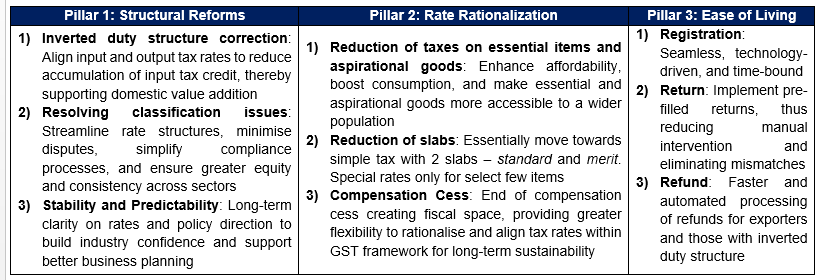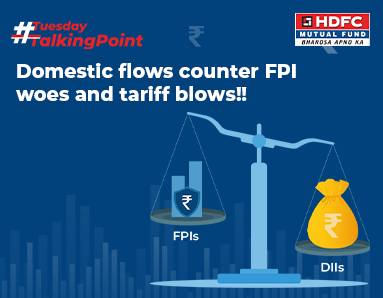Tuesday's Talking Points
GST Reforms – An Important Fiscal Move to Support Consumption!
What’s the Point?
- On the 79th Independence Day, the Prime Minister of India, Shri Narendra Modi highlighted that Central Government has planned to rationalize the Goods and Services Tax (GST) structure.
- These reforms could translate to an estimated economic boost of around ₹2.4 lakh crore (Source: Kotak Institutional Equities [KIE]) by reducing classification-related disputes, correcting inverted duty structures in specific sectors, ensuring greater rate stability, and further enhancing ease of doing business.
- Lower GST rates could complement other potential positives for India’s consumption growth recovery, such as income tax rate cuts, monetary easing, higher welfare spends and prospects of higher-than-average monsoon. Since Private Final Consumption Expenditure accounts for ~60% of GDP, any factors that support consumption will provide impetus to India’s economic growth
GST Collections – Setting Numbers into Perspective
- India’s GST collections have grown steadily with average monthly GST collections clocking over ₹2 lakh crore for the first time in 4MFY26 (Apr-Jul 25), outpacing the average monthly collections between 4MFY22 and 4MFY25.
- Tax payers filing after due date have reduced by 12% between FY22 and FY25, which indicates higher compliance and discipline, and reduced Government revenue uncertainty.
- Detection of GST evasion has become quicker and audit coverage under GST has risen from 62.2% in FY23 to 88.7% in FY25 with no taxpayer audited more than once in a 3-year span. E-way bills generation – a key indicator to monitor goods movement and reduce evasion – has risen nearly 2x between FY22 and FY26YTD.

Source: Centre for Monitoring Indian Economy (CMIE), *FY26YTD: April 30, 2025 to July 31, 2025
What is expected in the Next Phase of GST Reforms?
As per Press Information Bureau (PIB), the Central Government is proposing significant reforms in GST with the goal of building an Atmanirbhar Bharat. It will be focused on 3 pillars, namely:

Implication of GST Reforms – Expectation of Rise in Consumption
As mentioned above, India’s GST structure is expected to shift from a 4-tiered structure (5%, 12%, 18%, 28%) to a 2-tiered structure (5% and 18%). By virtue of this, it is expected taxes on different product segments and categories would get simplified. In essence, most of non-discretionary goods should fall into lower bracket of 5% and discretionary goods should fall into 18% bracket. The table below provides a snapshot of the current GST rate structure:

Source: UBS, GST Network
As per noted research reports and publicly available information, the biggest beneficiary of the change, in addition to Cement and Air Conditioners, is expected to be auto sector, with 2-wheelers, 3-wheelers, Smaller Passenger Vehicles and Commercial Vehicles, which are likely to fall in the lower 18% tax bracket as against the higher 28% tax bracket. In addition to this, rationalization is expected in the consumer staples sector, with goods moving from the 12% tax bracket to 5% tax bracket. With goods meant for mass consumption and aspirational goals likely move to lower rates, it could help reduce inflation and could create room for further easing of Monetary Policy.
Conclusion
In the last 8 years, GST has helped in formalization of the Indian economy, made tax compliance easier, reduced costs for businesses, and allowed goods to move freely across states. Despite that, the y-o-y growth rate in India’s total GST collections have decreased – going from 20.9% between FY22 and FY23 to 9.6% between FY24 and FY25. This was majorly driven by: a) a slowdown in consumption, particularly for discretionary goods in urban areas with consumer spending shifting away higher GST rate levied on luxury goods, b) higher difficulty in replicating the high base effect created by the strong growth in GST collections in FY24, and c) a slower-than-expected pickup in rural demand for certain key sectors like FMCG.
Against this backdrop, the GST reforms would likely lead to an increase in revenue deficit, which could put pressure on fiscal deficit. Having said that, since the Government is focused on reviving consumption in the economy, GST reforms are expected to aid the same through lower retail prices commensurate to tax cuts and related volume growth. Keeping the above points in mind, investors could consider investing in
HDFC Non-Cyclical Consumer Fund and HDFC Transportation and Logistics Fund. HDFC Non-Cyclical Consumer Fund aims to invest in companies, which are (a) Across different market cap segments, (b) Leaders and/or are gaining market shares due to better execution, scale, better adoption of technology etc., while focussing equally on companies which are likely to witness steady and secular growth, and (c) Likely to see a turnaround in profitability and have potential of being re-rated.
HDFC Transportation and Logistics Fund aims to invest in companies, which are (a) Within the basic industries like Passenger Cars and Utility Vehicles, 2/3 Wheelers, Auto Components and Equipment, etc., (b) Across different market cap segments, (c) Leaders or have potential to become market leaders in their respective segments, and (d) Have potential to benefit from evolving landscape in transportation and logistics theme.
Sources: CMIE, GST Network, PIB, MoSPI, KIE, and other publicly available information
About Tuesday’s Talking Points (TTP): TTP is an effort by HDFC AMC to guide key conversations in the Indian financial markets and investing ecosystem. We aspire to do this by providing relevant facts, along with our perspective on the issue at hand. Please provide your feedback at this link: https://forms.office.com/r/Cr8JNjMGWk
Disclaimer: Views expressed herein are based on information available in publicly accessible media, involve known and unknown risks and uncertainties that could cause actual results, performance, or events to differ materially from those expressed or implied herein. The information herein is for general purposes only.
Stocks/Sectors/Views referred are illustrative and should not be construed as an investment advice or a research report or a recommendation by HDFC Mutual Fund (“the Fund”) / HDFC Asset Management Company Limited (HDFC AMC) to buy or sell the stock or any other security. The Fund/ HDFC AMC is not indicating or guaranteeing returns on any investments. Past performance may or may not be sustained in the future and is not a guarantee of any future returns. The recipient(s), before taking any decision, should make their own investigation and seek appropriate professional advice.
MUTUAL FUND INVESTMENTS ARE SUBJECT TO MARKET RISKS, READ ALL SCHEME RELATED DOCUMENTS CAREFULLY.
Product Labelling and Riskometer of HDFC Non-Cyclical Consumer Fund
|
HDFC Non-Cyclical Consumer Fund (An open-ended equity scheme following non-cyclical consumer theme) is suitable for investors who are seeking*: |
Riskometer#
|
|
|
|
*Investors should consult their financial advisers, if in doubt about whether the product is suitable for them.
#For latest riskometer, investors may refer to the Monthly Portfolios disclosed on the website of the Fund viz. www.hdfcfund.com . |
The Scheme being thematic in nature carries higher risks versus diversified equity mutual funds on account of concentration and sector specific risks.


